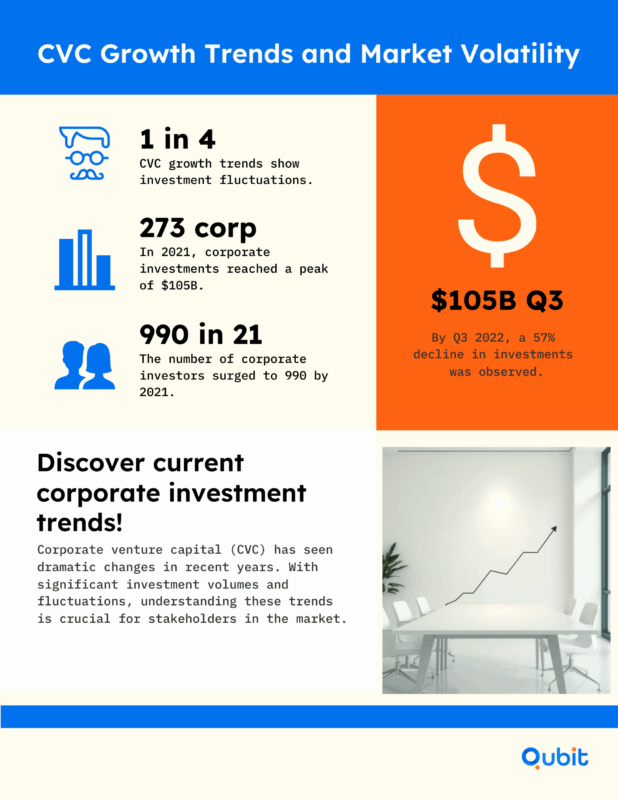Did you know that over 25% of all venture capital fund investments now come from corporate venture arms? As startup funding becomes more competitive, understanding how to navigate this powerful segment of the investment landscape is crucial.
This guide unpacks the nuances of corporate venture capital, offering founders actionable strategies to secure funding and build lasting strategic partnerships.
Whether you're seeking capital, mentorship, or market access, aligning with the right venture capital for startups can be a game-changer. You gain clarity on distinct investment profiles through insights provided in types of investors in startups, which outlines various investor categories and their characteristics. characteristics. This foundational knowledge can help you tailor your approach effectively.
What You Need to Know About Corporate Venture Capital
Corporate venture capital (CVC) is transforming how businesses engage with innovation. This model involves corporations directly investing their own funds into startups, fostering growth while gaining access to cutting-edge technologies and ideas. Unlike traditional venture capital, CVC focuses on strategic benefits, such as expanding market reach or securing a competitive edge, alongside financial returns.
Over the past decade, corporate venture capital has seen remarkable growth. Deal values have surged, and its relevance has expanded across industries like healthcare and information technology. For startups, CVC offers more than just funding—it provides access to resources, expertise, and networks that can accelerate their development.
This approach is particularly impactful in sectors where innovation drives success. In healthcare, for instance, CVC investments often target groundbreaking treatments or medical technologies. Similarly, in IT, corporations use CVC to tap into emerging trends like artificial intelligence and cloud computing, ensuring they stay ahead in a rapidly evolving market.
By aligning corporate goals with startup innovation, CVC creates a mutually beneficial relationship. Startups gain the support they need to scale, while corporations secure a foothold in future markets. This synergy underscores why venture capital for startups has become a cornerstone of modern business strategy.
Why Corporations Choose to Invest in Venture Capital
Corporations increasingly turn to venture capital (VC) as a strategic tool to thrive in fast-evolving markets. This approach enables them to adapt to technological advancements while safeguarding their position against disruptive innovations.
One major reason corporations invest in VC is to stay ahead of rapid technological changes. By funding startups, they gain access to cutting-edge technologies and insights that can reshape industries. This proactive strategy helps corporations avoid being blindsided by market disruptions. For example, corporate venture capital (CVC) often complements broader capital-raising strategies, allowing businesses to diversify their investments while fostering innovation.
Beyond financial returns, corporations pursue strategic benefits through VC investments. These include enhanced market sensing capabilities and reduced risks in mergers and acquisitions (M&A). A lack of due diligence in acquisitions can lead to significant losses, as illustrated by General Electric’s (GE) acquisition of Alstom’s coal-fueled turbines in 2015. GE’s $9.5 billion deal resulted in substantial losses due to insufficient market alignment and foresight. This underscores the importance of strategic alignment in corporate investments.
Moreover, aligning startup goals with corporate investors can foster collaboration and mitigate risks in venture deals. For founders seeking to partner with corporate investors, understanding shared objectives is crucial. A deeper analysis of partnership dynamics can be found in discussions on aligning startup goals with corporate investors, which highlights how shared objectives can drive successful outcomes.
Ultimately, venture capital investments allow corporations to innovate, adapt, and minimize risks in an increasingly competitive landscape. By combining financial and strategic objectives, they position themselves to thrive in the face of uncertainty.
How Corporate Venture Capital Differs from Traditional VC
Corporate venture capital (CVC) introduces a unique dynamic to the investment landscape, setting itself apart from traditional venture capital (VC) in several key ways. While traditional VCs prioritize financial returns above all else, CVCs often balance financial objectives with strategic goals, such as gaining market insights or fostering innovation within their industry. This dual focus can significantly impact how founders approach partnerships and structure deals.
Strategic Objectives vs. Financial ROI
Traditional VCs are laser-focused on maximizing return on investment (ROI), often within a shorter timeframe. In contrast, corporate VCs integrate strategic objectives into their decision-making process. Sid Ramtri of McKinsey highlights this dual value, stating, “Corporate venture capital not only generates attractive financial returns but also provides critical strategic advantages through market insights.” For founders, this means that CVCs may prioritize investments that align with their parent company’s long-term vision, such as entering new markets or enhancing technological capabilities.
Investment Horizons
Another distinguishing factor is the investment horizon. Corporate VCs typically operate with a longer-term perspective, allowing startups more time to grow and innovate. This contrasts with traditional VCs, who often push for quicker exits to realize financial gains. Jun Victoria Kasper emphasizes this point, noting, “Corporate venturing is not just about financial gains but a strategic tool for companies to remain competitive and innovative.” This extended timeline can be advantageous for founders seeking sustained support rather than rapid scaling.
Access to Resources
Corporate VCs also bring extensive resources to the table, including industry expertise, distribution networks, and operational support. These resources can be invaluable for startups aiming to scale efficiently or gain competitive advantages. Traditional VCs, while offering financial backing and mentorship, may lack the industry-specific resources that corporate investors provide.
Understanding these differences is crucial for founders when structuring deals and evaluating long-term benefits. Your understanding of deal structures is enriched through the exploration of negotiating with corporate investors, which examines effective approaches to partnership discussions.
By recognizing the unique advantages and trade-offs of corporate venture capital, founders can make more informed decisions that align with their growth objectives and strategic goals.
Corporate Venture Capital Trends and Their Impact on You

The rise of corporate venture capital (CVC) is reshaping how industries innovate and adapt to change. With corporate-backed investments becoming mainstream, the number of corporate venture funds has surged dramatically. In 2021 alone, 990 corporate entities invested in startups, a significant leap from just 273 in 2011. This growth reflects the strategic importance of CVC in fostering innovation and maintaining competitive intelligence in fast-evolving sectors.
CVC’s role in driving industry transformation cannot be overstated. By investing in startups, corporations gain access to emerging technologies and market insights, enabling them to stay ahead in sectors where the volume of information doubles every 11 hours, according to IBM. This rapid pace of change underscores the necessity for businesses to align with innovative ventures to remain relevant.
However, the cyclical nature of venture investments presents challenges. For instance, corporate venture capital investments peaked at $105 billion in Q3 2021 but experienced a sharp 57% decline in Q3 2022 due to market volatility. This fluctuation highlights the inherent risks in the CVC ecosystem, emphasizing the need for strategic planning and adaptability. For further insights into how virtual deal making trends are shaping the CVC landscape, refer to TechCrunch.
Understanding the challenges of working with corporate investors can provide valuable context for navigating these fluctuations. Explore the challenges of working with corporate investors to gain practical knowledge on overcoming obstacles and identifying opportunities in this dynamic environment.
As CVC continues to grow, its impact on industries and individual businesses will deepen. Whether you’re a startup founder or a corporate leader, staying informed about these trends is essential for leveraging the opportunities and mitigating the risks associated with corporate-backed investments.
Your Quick Summary of Corporate Venture Capital
Corporate venture capital (CVC) represents a strategic intersection between corporate innovation and startup funding. It enables established companies to invest in emerging businesses, fostering innovation while aligning with broader corporate objectives. By integrating venture funding models into their strategies, corporations can access cutting-edge technologies, diversify revenue streams, and strengthen their competitive positioning.
This approach is not just about financial returns; it’s also a pathway to strategic growth. For founders, understanding how corporate strategies align with venture capital models can inspire new opportunities, including the decision to start a venture capital fund. Whether you're a startup seeking investment or a corporation exploring CVC, the principles discussed here provide a solid foundation for actionable next steps.
As you consider the potential of corporate venture capital, remember that aligning strategic goals with funding opportunities is key to unlocking long-term success.
Discover What Our Partner Center Can Offer You
Unlock a world of subscription and partnership opportunities through our Partner Center. Designed to provide valuable resources, it offers external links to explore corporate policies and partnership frameworks in depth. Whether you're interested in creating a venture capital fund or expanding your network, the Partner Center is your gateway to actionable insights.
We encourage readers to amplify their discoveries by sharing them on platforms like Twitter. Use the Twitter share link to post this guide on your timeline and help spread knowledge about venture capital opportunities.
Take advantage of the tools and connections available to build meaningful collaborations. Whether you're exploring policies or sharing insights, the Partner Center is here to support your growth.
Key Ingredients for Corporate VC Success
Establishing a thriving corporate venture capital (CVC) unit requires a blend of strategic foresight and operational precision. A dedicated CVC unit with operational independence is fundamental. This autonomy allows the team to focus on identifying and nurturing high-potential investments without being hindered by the parent company’s day-to-day operations.
Equally important is a robust governance framework. This ensures that the CVC unit aligns with the parent organization’s strategic goals while maintaining the flexibility to make timely investment decisions. Clear governance structures also help balance long-term strategic priorities with immediate financial objectives.
A well-defined investment strategy is another cornerstone of success. By setting clear criteria for target sectors, deal sizes, and expected outcomes, CVC units can systematically pursue opportunities that align with both financial returns and strategic growth. Complementing this, performance metrics are essential for tracking progress. These metrics should evaluate not only financial returns but also the strategic value added to the parent organization.
Lastly, incorporating sustainability and ESG (Environmental, Social, and Governance) criteria into investment decisions is no longer optional. This approach not only ensures long-term viability but also aligns with evolving market expectations and regulatory standards.
Conclusion
Strategic alignment is the cornerstone of successful corporate venture capital (CVC) investments. Throughout this discussion, we’ve explored how aligning financial goals with strategic objectives can amplify the impact of CVC initiatives. By focusing on both dimensions, companies can ensure their investments not only generate returns but also drive innovation and long-term growth.
Understanding the dual nature of CVC—balancing financial performance with strategic value—is essential for making informed decisions. This approach enables businesses to identify opportunities that resonate with their core mission while fostering partnerships that deliver tangible benefits.
If you're seeking expert guidance to optimize your fundraising efforts, we at Qubit Capital are here to assist. Explore our Fundraising Assistance service to unlock tailored strategies for your venture.
Key Takeaways
Corporate venture capital (CVC) uniquely combines the pursuit of financial returns with the strategic goal of driving innovation within the parent company.
Unlike traditional VC, CVC typically offers a longer-term investment horizon and access to valuable corporate assets such as distribution channels, R&D, and brand credibility.
While CVC investment has grown significantly in recent years, it remains sensitive to market volatility and shifting corporate priorities — requiring startups to navigate this landscape with care.
For CVC initiatives to succeed, strong governance frameworks, well-defined performance metrics, and a commitment to sustainability are essential.
To fully unlock the advantages of corporate backing, founders must ensure strategic alignment between the startup’s mission and the corporation’s long-term objectives, fostering collaboration that benefits both sides.
Frequently asked Questions
What is the 80/20 rule in venture capital?
The 80/20 rule in venture capital suggests that 80% of your returns come from 20% of your investments. This highlights the importance of identifying and focusing on high-impact opportunities that can yield significant returns.


 Back
Back



